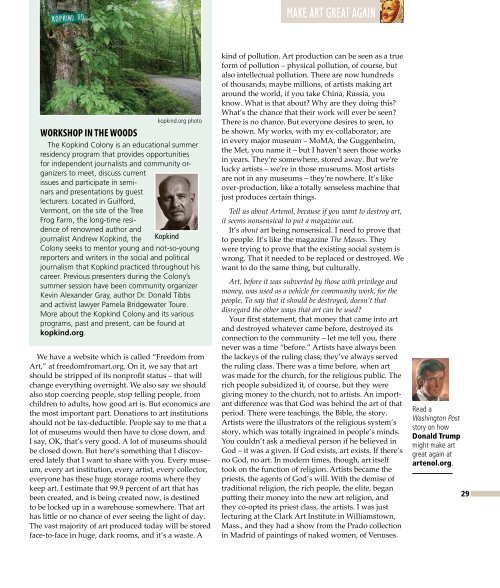artenol0416_sm_flipbook
You also want an ePaper? Increase the reach of your titles
YUMPU automatically turns print PDFs into web optimized ePapers that Google loves.
MAKE ART GREAT AGAIN<br />
WORKSHOP IN THE WOODS<br />
The Kopkind Colony is an educational summer<br />
residency program that provides opportunities<br />
for independent journalists and community organizers<br />
to meet, discuss current<br />
issues and participate in seminars<br />
and presentations by guest<br />
lecturers. Located in Guilford,<br />
Vermont, on the site of the Tree<br />
Frog Farm, the long-time residence<br />
of renowned author and<br />
journalist Andrew Kopkind, the<br />
kopkind.org photo<br />
Kopkind<br />
Colony seeks to mentor young and not-so-young<br />
reporters and writers in the social and political<br />
journali<strong>sm</strong> that Kopkind practiced throughout his<br />
career. Previous presenters during the Colony’s<br />
summer session have been community organizer<br />
Kevin Alexander Gray, author Dr. Donald Tibbs<br />
and activist lawyer Pamela Bridgewater Toure.<br />
More about the Kopkind Colony and its various<br />
programs, past and present, can be found at<br />
kopkind.org.<br />
We have a website which is called “Freedom from<br />
Art,” at freedomfromart.org. On it, we say that art<br />
should be stripped of its nonprofit status – that will<br />
change everything overnight. We also say we should<br />
also stop coercing people, stop telling people, from<br />
children to adults, how good art is. But economics are<br />
the most important part. Donations to art institutions<br />
should not be tax-deductible. People say to me that a<br />
lot of museums would then have to close down, and<br />
I say, OK, that’s very good. A lot of museums should<br />
be closed down. But here’s something that I discovered<br />
lately that I want to share with you. Every museum,<br />
every art institution, every artist, every collector,<br />
everyone has these huge storage rooms where they<br />
keep art. I estimate that 99.9 percent of art that has<br />
been created, and is being created now, is destined<br />
to be locked up in a warehouse somewhere. That art<br />
has little or no chance of ever seeing the light of day.<br />
The vast majority of art produced today will be stored<br />
face-to-face in huge, dark rooms, and it’s a waste. A<br />
kind of pollution. Art production can be seen as a true<br />
form of pollution – physical pollution, of course, but<br />
also intellectual pollution. There are now hundreds<br />
of thousands, maybe millions, of artists making art<br />
around the world, if you take China, Russia, you<br />
know. What is that about? Why are they doing this?<br />
What’s the chance that their work will ever be seen?<br />
There is no chance. But everyone desires to seen, to<br />
be shown. My works, with my ex-collaborator, are<br />
in every major museum – MoMA, the Guggenheim,<br />
the Met, you name it – but I haven’t seen those works<br />
in years. They’re somewhere, stored away. But we’re<br />
lucky artists – we’re in those museums. Most artists<br />
are not in any museums – they’re nowhere. It’s like<br />
over-production, like a totally senseless machine that<br />
just produces certain things.<br />
Tell us about Artenol, because if you want to destroy art,<br />
it seems nonsensical to put a magazine out.<br />
It’s about art being nonsensical. I need to prove that<br />
to people. It’s like the magazine The Masses. They<br />
were trying to prove that the existing social system is<br />
wrong. That it needed to be replaced or destroyed. We<br />
want to do the same thing, but culturally.<br />
Art, before it was subverted by those with privilege and<br />
money, was used as a vehicle for community work, for the<br />
people. To say that it should be destroyed, doesn’t that<br />
disregard the other ways that art can be used?<br />
Your first statement, that money that came into art<br />
and destroyed whatever came before, destroyed its<br />
connection to the community – let me tell you, there<br />
never was a time “before.” Artists have always been<br />
the lackeys of the ruling class; they’ve always served<br />
the ruling class. There was a time before, when art<br />
was made for the church, for the religious public. The<br />
rich people subsidized it, of course, but they were<br />
giving money to the church, not to artists. An important<br />
difference was that God was behind the art of that<br />
period. There were teachings, the Bible, the story.<br />
Artists were the illustrators of the religious system’s<br />
story, which was totally ingrained in people’s minds.<br />
You couldn’t ask a medieval person if he believed in<br />
God – it was a given. If God exists, art exists. If there’s<br />
no God, no art. In modern times, though, art itself<br />
took on the function of religion. Artists became the<br />
priests, the agents of God’s will. With the demise of<br />
traditional religion, the rich people, the elite, began<br />
putting their money into the new art religion, and<br />
they co-opted its priest class, the artists. I was just<br />
lecturing at the Clark Art Institute in Williamstown,<br />
Mass., and they had a show from the Prado collection<br />
in Madrid of paintings of naked women, of Venuses.<br />
Read a<br />
Washington Post<br />
story on how<br />
Donald Trump<br />
might make art<br />
great again at<br />
artenol.org.<br />
29

















